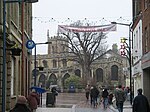Woodwalton
Wood Walton is a village and civil parish in Cambridgeshire, England. Wood Walton lies approximately 6 miles (10 km) north of Huntingdon and just east of the A1. Wood Walton is situated within Huntingdonshire which is a non-metropolitan district of Cambridgeshire as well as being a historic county of England. The civil parish of Wood Walton is spread over a wide area, the main village dissected by the East Coast Main Line. To the north of the village in the area known as "Church End" stands the (now redundant) parish church of St Andrew, clearly visible from passing trains. The church was listed as one of Songs of Praise's favourite churches. The church dates from around 1200 and is layered in history: the south aisle was added in 1250, a clerestory was added in the 16th century, and it received a major remodelling in the 1850s. It is now in the keeping of the Friends of Friendless Churches.Further north are the earthworks of Woodwalton Castle, a motte-and-bailey castle which formerly held the manor of the parish. In 1886 a hoard of Roman coins was dug up in the parish. The village stands at the edge of Woodwalton Fen, an area of special scientific interest.
Excerpt from the Wikipedia article Woodwalton (License: CC BY-SA 3.0, Authors).Woodwalton
The Green, Huntingdonshire
Geographical coordinates (GPS) Address Nearby Places Show on map
Geographical coordinates (GPS)
| Latitude | Longitude |
|---|---|
| N 52.413 ° | E -0.216 ° |
Address
The Elephant & Castle
The Green
PE28 5YN Huntingdonshire
England, United Kingdom
Open on Google Maps









